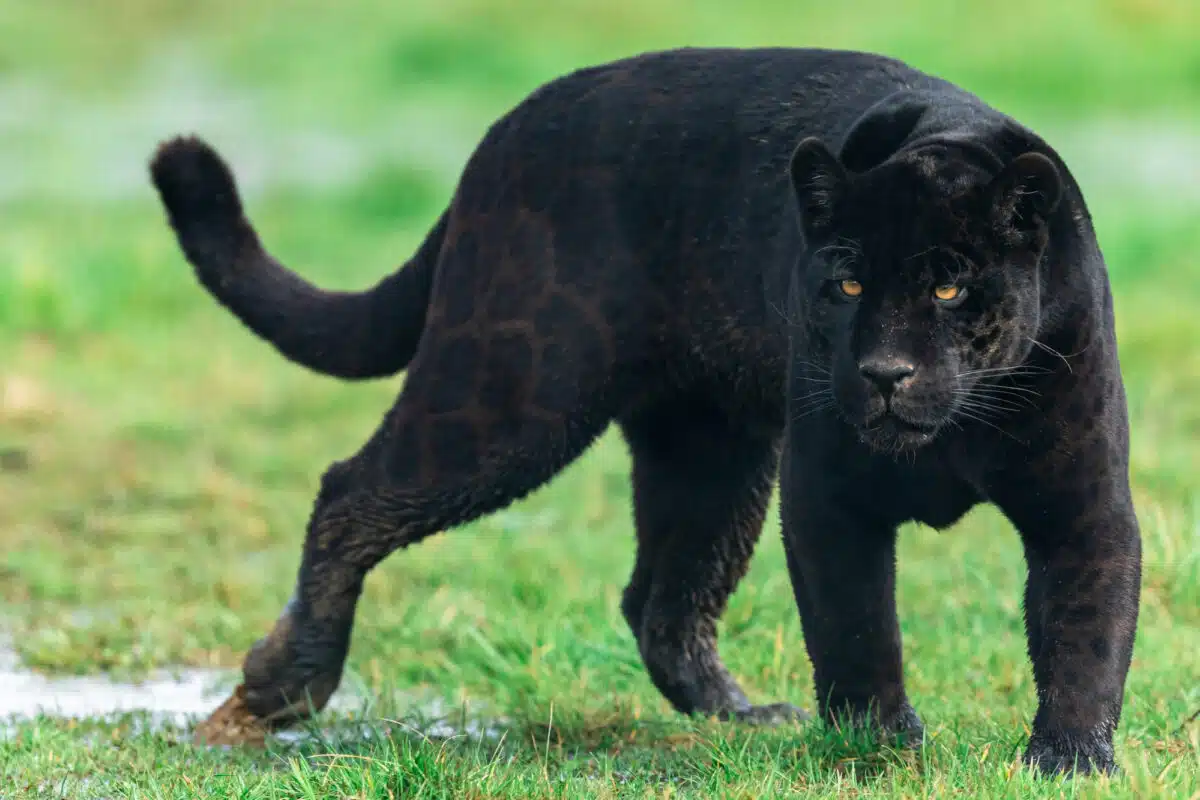Welcome to this article about the 10 most interesting black animals.
Black is bold and beautiful. Many color psychologists believe black symbolizes mystery and intrigue, and you can certainly say this about many black animals.
Of all the colors in nature, black is the only one that can exist without light reflection. So, in a technical sense, you can say black is not a color at all but an absence of color. This makes for an interesting viewpoint when it comes to animal biology because most black animals have an abundance of the coloring pigment melanin.
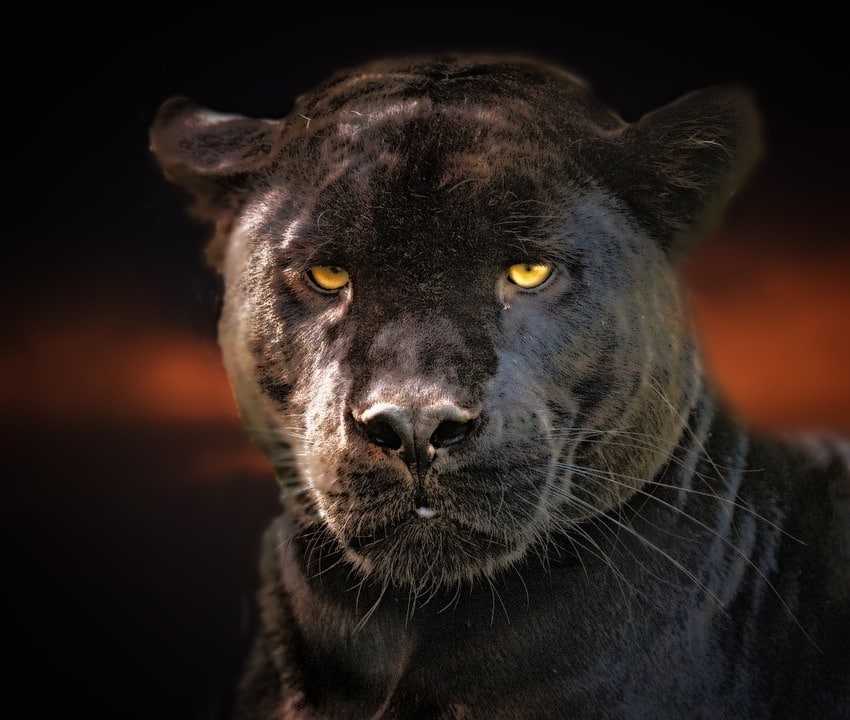
Melanin is the natural pigment found in most organisms, giving them their color. It is of various types, and different melanin pigments are responsible for the varying shades of color across species. A lack or deficiency of this pigment results in albinism.
Eumelanin is the typical melanin type that causes black coloration in black animals. Generally, mammals synthesize this melanin for skin coloration and protection from damaging solar radiation. However, Insects are even more innovative with their use of melanin, as they utilize it in external pigmentation, exoskeletal hardening, healing, and immune responses.
With this in mind, black animals should not be confused with melanistic animals who suffer from melanism. Melanism is a mutated condition that causes excessive development of eumelanin in the skin and appendages, making the animal completely black and devoid of its natural specie color.
Distinctions Between Black Animals And Melanistic Animals
Black is black. Who cares which black is which? Right? Wrong. Yes, melanistic animals are black, but the difference between them and naturally black creatures is that melanism is a genetic anomaly.
While black animals are predominantly dark across their species, melanistic animals are unique individuals who are part of a larger species but have divergent pigmentation genes. For example, the popular black panther is often confused with a black feline species, but these wildcats are only melanistic color variants of the leopard and Jaguar.
Other than their color, every other aspect of their existence, including hunting, feeding, mating, and reproductive behavior, remains consistent with other individuals of their species.
If you can get close enough, you’ll see that the rosette formation typical of a leopard’s and jaguar’s fur remains in black panthers, only it may not be visible from afar.
What Makes Black Animals Interesting?
As mentioned earlier, black animals are mysterious and intriguing. Not many species don black exclusively compared to other colors for a color so ubiquitous. This is fascinating because black is a very practical color, and it makes for efficient camouflage and pronounced aposematic coloration to scare off predators.
Yet, the number of animals that spot this color is few and far between, making the animals that do stand out even more. Among these animals are black mammals, reptiles, birds, insects, and amphibians. So you can see, even though there are few, they are still well-represented across the animal kingdom.
Let’s take a look at some of these amazing creatures.
10. Ravens
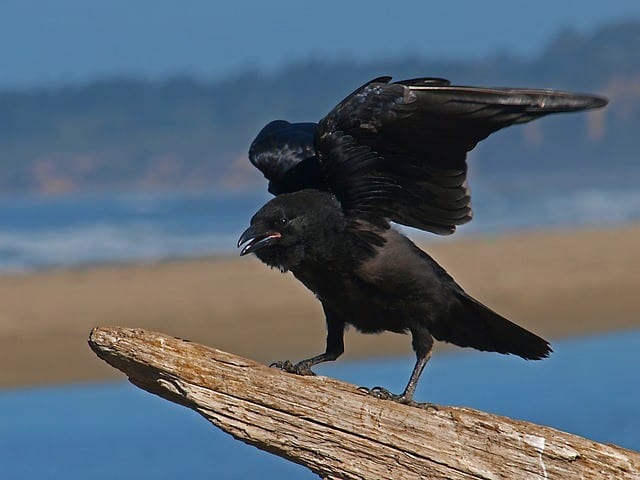
Ravens are one of the largest birds in the crow family, and they can weigh up to 2kg with a length of 67cm and a wingspan of 150cm. They inhabit a wide range of habitats, from the arctic and temperate habitats in Europe, Asia, and North America, to the Saharan Africa’s desert and the Pacific Ocean’s isolated islands.
Ravens are jet-black animals, and this color has often mystified many who believe they symbolize bad luck. However, in many other cultures, like in Scandinavian and Nordic folklore, they are revered as god-like emissaries.
These birds are extremely intelligent and have been recorded fashioning simple tools from twigs and stones, along with some members of their crow family.
Ravens have also been reported to be as smart as apes. This is another reason why they are so immersed in myth. Many folks just can’t fathom a bird being this smart.
Being sociable animals, ravens often travel in mated pairs of two or with a flock. They are very coordinated and quickly alert each other to predators if they see one nearby. This makes them difficult prey, so they generally have few natural predators. However, their eggs and hatchlings are vulnerable and often attacked by owls, eagles, and falcons.
Similar to other crow birds, ravens are omnivores, surviving on fruits, grains, acorns, and birds. Meanwhile, their protein comes from small invertebrates, reptiles, amphibians, and occasionally carrion when available.
9. Pilot Whales
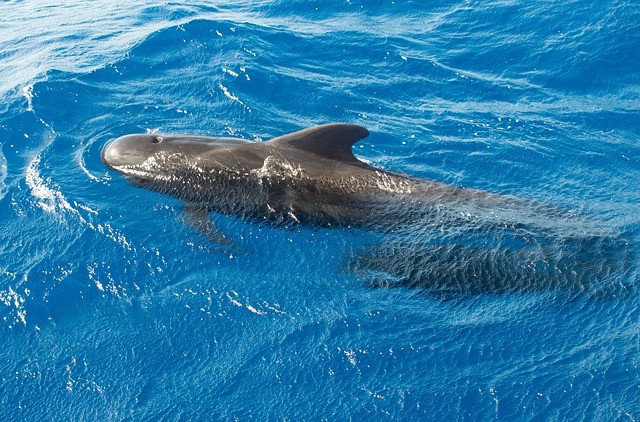
Pilot whales get their names from the long-held belief that a pilot led them in their pods. These cetaceans are aptly given the name blackfish because of their black color. They are one of the largest sea dolphins and are only surpassed by the orca in size.
There are two living species of these animals in their genus, the short-finned pilot whale and the long-finned pilot whale. Both are hardly distinguishable and favor slightly different habitats, but between them, they range almost worldwide.
Long-finned whales favor colder waters; hence, they are found around polar regions in the North Atlantic and Southern Ocean. On the other hand, short-finned pilot whales prefer temperate, tropical, and subtropical waters in the Indian, Atlantic, and Pacific oceans.
These black animals have strong social structures and live in pods of 30 to 100 individuals, hunting together for food mainly consisting of squids.
Along with humans and killer whales, female pilot whales are the only mammals who experience menopause. This helps the survival of their species, as post-productive whales still lactate and participate in nursing young members of the group.
Pilot whales are notorious for being stranded on beaches. Why this happens is still debated, but researchers believe it may be due to noise and water pollution damage to their innate echolocation system. As recently as October 2022, over 500 pilot whales died of stranding off the coast of New Zealand.
8. Black Saddlebags Skimmer
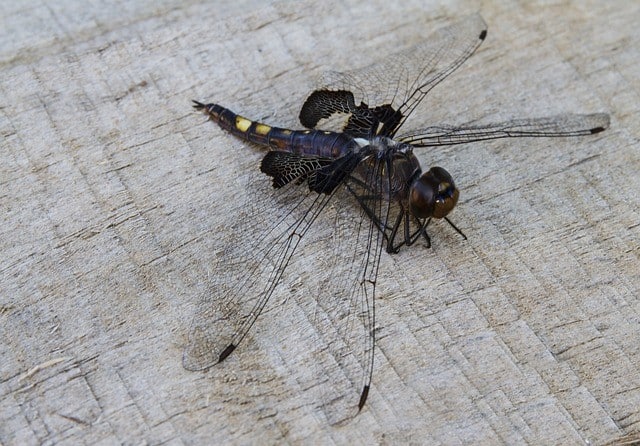
The black saddlebag is a specie of skimmer dragonfly native to North America. Here, they are found around stagnant and slow-moving water bodies like ponds and lakes.
They are so named because of their wings which are distinctive for their characteristic black blotches, which make them look like they are carrying saddle bags.
These large insects grow up to 5cm, but there are nowhere near the giant darner dragonflies that can grow up to 13cm.
Like most dragonflies, they live mostly on or around water, where they feed, mate, and lay eggs.
Black saddlebags feed on tiny aquatic insects like mosquitoes, water mites, and water lice. And their larvae also feed on the larvae of these insects. As a result, they have been introduced into some ecological niches. That’s because both adult and larval forms of these black animals are efficient for mosquito control.
7. Bonobos
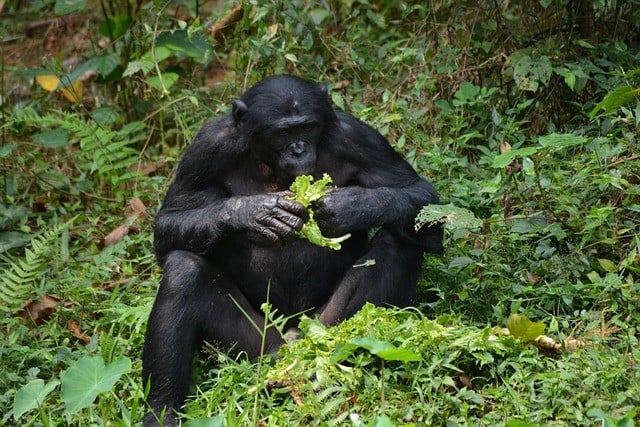
The Bonobo is an endangered ape species endemic to a small area of the Congo basin, south of the Congo river, in the Democratic Republic of Congo. Along with chimpanzees, these apes are our closest genetic relatives, sharing 98.7% of their DNA with humans.
Bonobos are easily distinguished from their chimpanzee cousins by their more agile and slender build. They also have dark faces and dark hair on their head that looks parted in the middle.
Although these black animals are mainly frugivorous, being responsible for most of the seed dispersion in the Congo rainforest. They sometimes supplement their diet with honey, eggs, and meat from invertebrates and rodents.
Bonobos are one of the most promiscuous animals in the world, and certainly the most promiscuous among primates. In a typical Bonobo society, sex is a ritual for bonding, resolving conflict, and strengthening relationships. These animals are among the few organisms that have sex for reasons other than strictly for reproduction.
Furthermore, bonobos’ casual outlook on sex often brings up situations where males and females engage in sexual interactions with members of the same gender. Thus, they are one of the few homosexual species in the wild.
6. American Black Bear
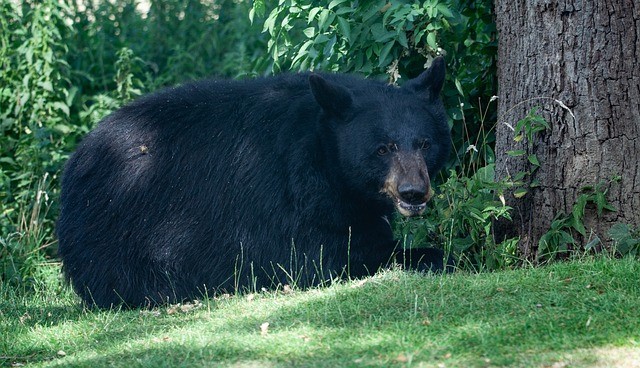
Also known simply as the black bear, the American black bear (read about the Asiatic Balck Bear here) is a medium-sized bear that inhabits the rainforests of North America, from Alaska in the north down south through Canada, the contingent United States, and Mexico.
These bears are closely related to the Asian black bear in that they are completely jet-black animals. The striking difference is the lack of the characteristic white crescent blaze on the chest that Asian black bears have.
They are omnivores, feeding on grasses, fruits, fish, carrion, and small mammals. Because they share their habitat range with bigger and more aggressive bear species like the grizzly bear, American black bears have carved a niche for themselves in the higher mountainous areas with elevations of up to 9,800ft. Hence they have evolved to be very strong climbers.
American black bears are such great survivalists that their populations in the United States are estimated to number up to 500,000. These estimates make American black bears the most populous bear species in the contiguous United States.
5. Moneilema
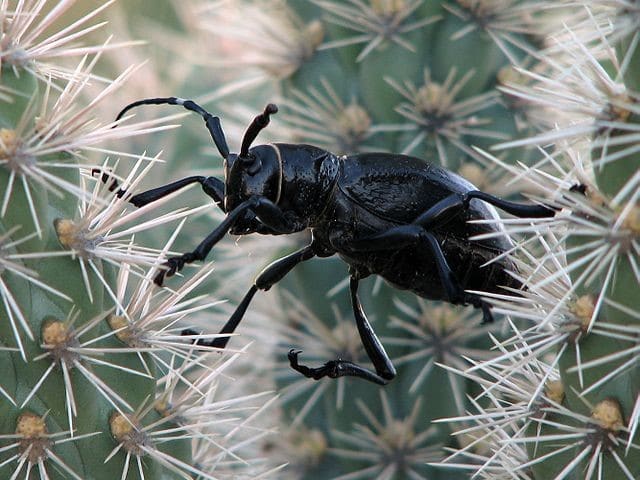
Commonly known as the cactus longhorn beetle, the moneilema is a genus consisting of black flightless beetles known to feed on cacti, like the saguaro, cholla, and prickly pear cactus.
These insects are native to the desert of the United States and Mexico, especially the Sonoran Desert. Though these beetle’s genus includes up to twenty species, each with its peculiarities, they are all black animals with fusiform hard exoskeletons and long antler-like antennas.
Beetles of this genus are pests that concern cactus growers because they can cause great damage to even big cacti plants like the saguaro or elephant cactus.
Interestingly, much of this damage results from the beetle’s larvae, not the adult. The juveniles can penetrate the hardy surfaces of the cactus plant, where they spend the winter and survive on the plant’s tissues till they reach adulthood in spring.
Therefore, it is not uncommon to see cacti collapsing on themselves during winter or spring as a result of tissue damage from moneilema.
4. Celebes Crested Macaque
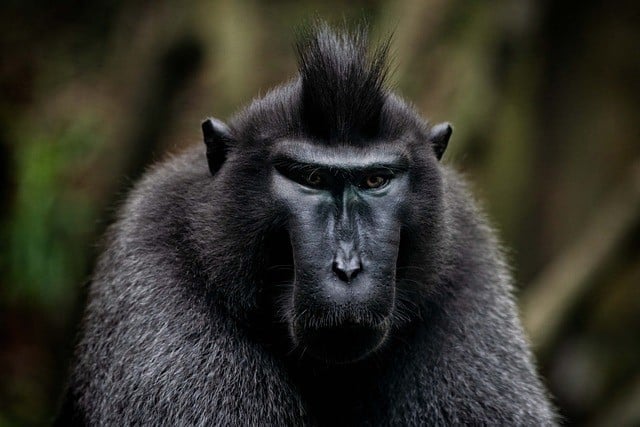
Also known as the crested black macaque or black ape, this old-world monkey exclusively lives in Indonesia on Sulawesi island, with scattered populations on the neighboring Bacan island. They are listed as critically endangered species, so many are housed in the Tangkoko nature reserve in Sulawesi, Indonesia.
The species gets its name from its native island [Sulawesi, formerly known as Celebes] and the characteristic black crest on its head. Except for some tinge of white hair around the shoulders, they are completely black, even around the face.
Although they are colloquially called black apes, crested macaques are actually monkeys. Their vestigial and almost non-visible tail gives them the appearance of apes. Like most monkeys, they are mainly frugivores, balancing their diet with eggs, insects, worms, and small vertebrates.
The macaque’s social structure is highly patriarchal, with groups having females that sometimes outnumber males from 4 to 1. This reduces the need for competition for females among males, and young adults usually leave the group when they mature.
Recently, in 2014, Celebes crested macaques were in the light of a controversial debate as to whether animals could own copyright. This controversy arose because of a copyright suit involving a selfie portrait taken by a crested macaque.
3. Ayam Cemani
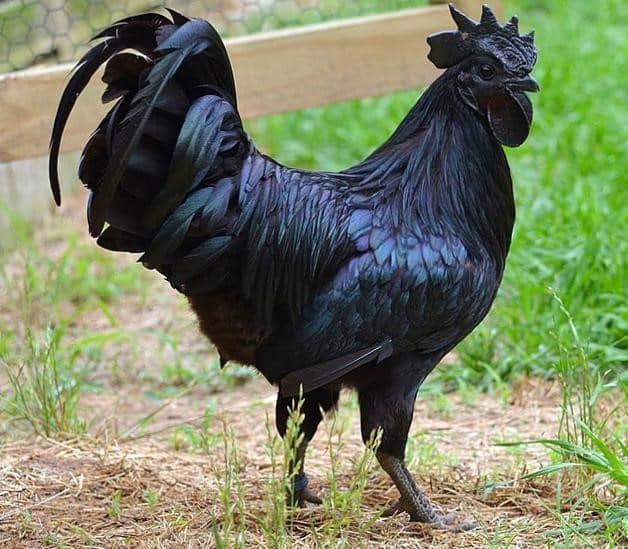
Another black animal originating from Indonesia, the Ayam cemani, is an interesting creature because it makes this list not as a representative of any genus or specie but as a breed of its own. It is also the only domestic animal on the list, and deservedly so.
The Ayam cemani is a chicken breed with a rare dominant gene that causes fibromelanosis, a form of hyperpigmentation. This condition is a tad different from melanism. Whereas melanism is usually a recessive trait, fibromelanosis is a dominant trait.
Also, and perhaps more distinctive, is the fact that fibromelanistic animals are black to the bones. The feathers, wattles, beaks, bones, and internal organs of fibromelanistic animals are all black. However, their blood remains red. This condition occurs in one other animal, the silkie, which also happens to be a chicken breed.
On the islands of Indonesia, where they live, ayam cemanis commonly feature as gamecocks for cockfighting because of their thicker thigh muscles, making them faster and more agile.
2. Eastern Indigo Snake
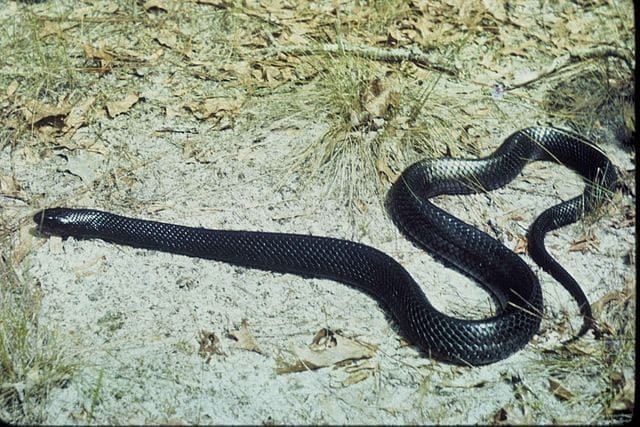
Though their name may suggest otherwise, the eastern indigo snake typically spots a blue-black coloration on their dorsal scales, making them more black animals than indigo. However, iridescence makes the scales appear a dark shade of purple when viewed up close, hence the name.
The eastern indigo is the longest snake native to North America, with recorded lengths of up to 9.2ft. They typically live in the southeastern corner of the United States. This includes South Carolina, Florida, Georgia, Alabama, and Mississippi.
These beautiful black animals are non-venomous, yet they are not constrictors. They immobilize their prey by grabbing it and beating it on a hard surface or quickly swallowing it alive.
Although eastern indigos are carnivores, feeding on eggs, mammals, fish, birds, and other snakes, these reptiles have a symbiotic relationship with the gopher tortoise. During winter, they cozy up in gopher tortoise burrows to keep warm. Perhaps because of the tortoise size, they do not prey on these particular animals.
Similarly, these snakes have a gentle temperament when approached by humans. They rarely attack when picked up but may bite if they feel threatened. This mild temperament and their dynamic colors make them sought-after by reptile pet breeders and owners.
1. Ziegler’s Crocodile Newt
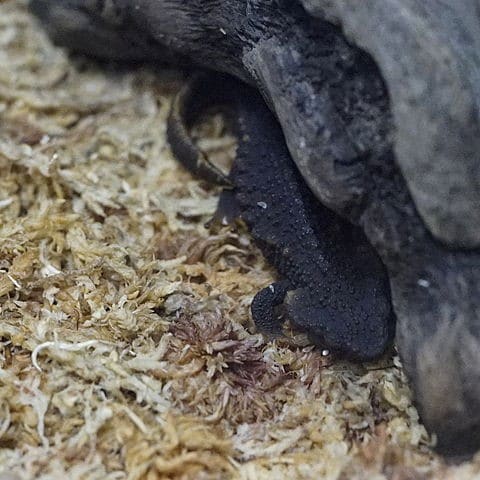
Ziegler’s crocodile newt is a specie of crocodile newts found in Vietnam and the southern provinces of China. This specie was recently discovered, so in-depth information about them has yet to be well known.
They grow up to three inches long, with a head much wider than most salamanders. The salamander species are uniquely bizarre in their appearance because they are completely black, except for tiny orange stripes on the tips of their toes and the underside of their tail.
This physical appearance, coupled with the fact that they are mostly terrestrial, gives many the impression that they are reptiles rather than amphibians.
Summary of the most interesting black animals
Black animals are pretty common, but we hope you found the 10 discussed in this article really interesting.
There are more intriguing animal facts in this post about white animals or pink animals. We recommend you have a look before leaving.
Join our Forum for free today!

- These are The 5 Largest Great White Sharks Ever Recorded - July 19, 2024
- The Surprising Benefits of Big Game Hunting - July 18, 2024
- $100k+ Hunting Experiences The Most Expensive Animals to Pursue - July 17, 2024

